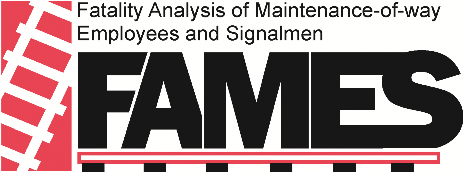Fatalities in Controlled Points/Manual Interlockings Published: Nov 23 2015 10:17AM

Dedication: The FAMES Committee dedicates its efforts to all roadway workers who have lost their lives in the performance of duty and to the families, loved ones, and coworkers they have left behind.
Mission Statement: The Mission of the Fatality Analysis of Maintenance-of-way Employees and Signalmen (FAMES) Committee is to analyze all fatalities and selected related incidents in order to make recommendations to reduce the risk of future occurrences and eliminate fatalities to roadway workers. Roadway Worker Fatalities in Controlled Points Although the implementation of Roadway Worker Protection (RWP) regulations in 1997 has had a positive impact, accidents in which Roadway Workers are killed or injured continue to occur. Of the 43 Roadway Worker fatalities analyzed by FAMES to date, 8 fatalities occurred within a controlled point/manual interlocking.
As prescribed in both Federal Railroad Administration (FRA) regulations and railroad rules, Roadway Workers (Lone Workers and Roadway Work Groups) are prohibited from fouling any track withinthe limits of a controlled point/manual interlocking unless on-track safety is established using one of the following methods:
1. Working Limits (Authority), or
2. Train Approach Warning (Watchman/Lookout).
“Individual Train Detection (ITD),” sometimes referred to as “Lone Worker protection,” must
NEVER be used as on-track safety by a Lone Worker within a controlled point/manual interlocking.
Findings: • All 8 of the fatal accidents within a controlled point/manual interlocking occurred on main track where switches were present:
o In 7 of the 8 fatal accidents,
NO on-track safety was established where the fatality occurred.
o In 1 of the 8 fatal accidents, Train Approach Warning (Watchman/Lookout) was the established form of on-track safety.
• 63% of all controlled point/manual interlocking fatalities (5 of 8) were
Signal employees.
• 83% of all
Signal employee RWP fatalities (5 of 6) occurred within the limits of a controlled point/manual interlocking.
• Passenger trains struck and killed 6 of the 8 employees.
• In 3 of the 8 accidents, the fatally injured employee was working alone
without any form of on-track safety. • In 6 of the 8 fatal accidents, an on-track safety briefing was not held or was insufficient.
Recommendations: •
Roadway Workers must
NEVER foul any track at a controlled point/manual interlocking until on-track safety has been established.
•
Lone Workers must
NEVER use Individual Train Detection (ITD) as a form of on-track safety within a controlled point/manual interlocking.
•
Each Roadway Worker and anyone joining a Roadway Work Group must participate in an on-track safety briefing before fouling any track. On-track safety must be appropriate for the job being performed.
• Train Approach Warning (Watchman/Lookout) may be used at a controlled point/manual interlocking. However, multiple routings, multiple tracks, job task, train speed, or other circumstances may make it necessary to establish working limits.
o Watchmen/Lookouts must focus their sole attention to the detection and warning of approaching trains and equipment.
o During the on-track safety briefing, the Roadway Worker-in-Charge must identify the method that Watchmen/Lookouts will use to indicate when it is safe for Roadway Workers to enter and re-enter the foul of the track.
• When establishing on-track safety, Roadway Workers should factor in that passenger trains operate at higher speeds and are generally quieter than freight trains.
• Never assume the time, track, or direction of the next train.
• Roadway Workers must not be in the foul of the track anytime they suspect that on-track safety is insufficient or no longer appropriate. Roadway Workers have a right and responsibility to initiate a good faith challenge and clear the track until the challenge is resolved.
The FAMES Committee consists of safety representatives from a cross section of rail labor, railroad management, and federal regulators. FAMES is a continuous improvement process that relies on the candid sharing of available data and the views of its participants. To enable the process, FAMES explicitly refrains from making any findings regarding whether any past or present practice or protocol satisfies any legal duty or standard of care.
The views, opinions, and recommendations contained in this report are those of the FAMES Committee and do not necessarily represent the views, opinions, or recommendations of any specific railroad, labor organization, or governmental agency.